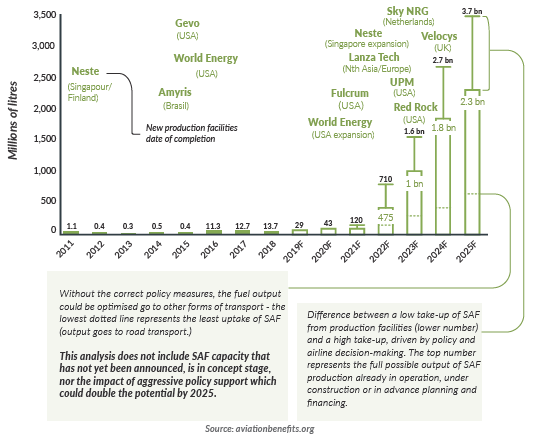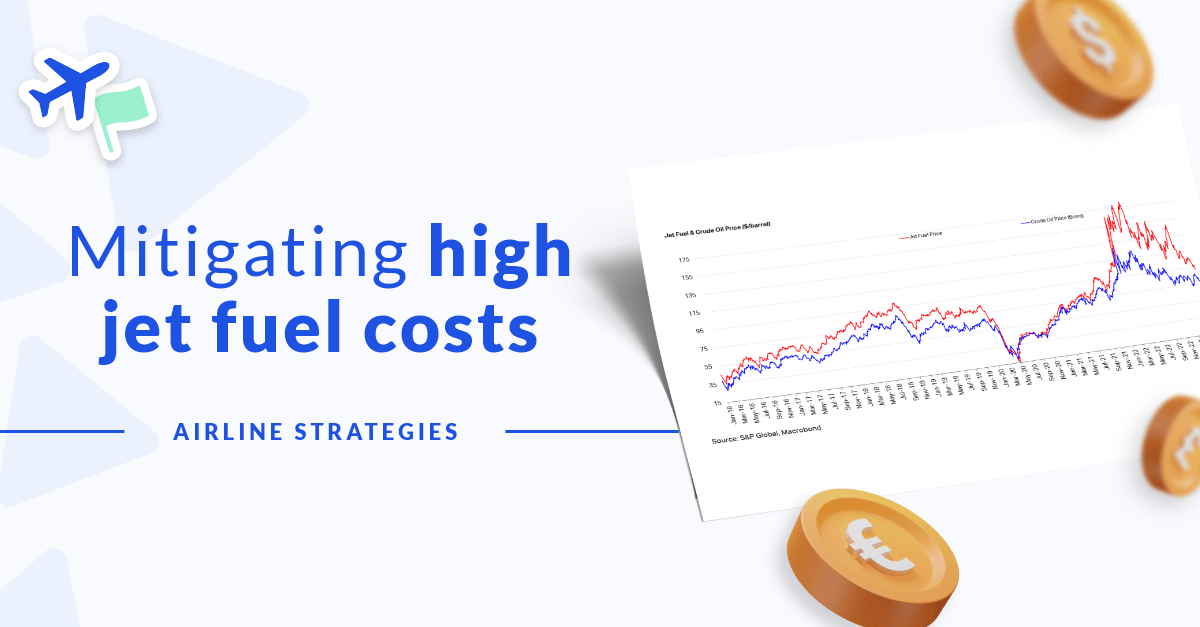Airline strategies for mitigating high jet fuel costs
To say that the past few years have been turbulent for the airline industry would be something of an understatement. The global health crisis, followed by the geopolitical confrontations in Eastern Europe, has had unprecedented consequences for airline operations and finances.
US airlines are not as affected as their European counterparts by the closure of Russian airspace. For instance, Europe’s airlines have had to add hours to services eastward for routes to Asia. Some carriers, such as Finnair, have even opted to go the other way around.
Meanwhile, concerns about the volatility of the global economy and oil demand will continue to impact costs for carriers operating out of the United States for the foreseeable future. While fuel prices have dropped from last year’s all-time highs, they remain elevated, leaving airlines with strategic dilemmas.
To hedge or not to hedge?
Fuel hedging is a financial strategy airlines employ to safeguard against volatile and fluctuating jet fuel prices, especially in times of geopolitical uncertainty. Airlines typically hedge prices up to two years in advance, although this can also range from six months to a year.
The exact duration depends on several factors, including long-term strategy, the airline’s assessment of market conditions, and how well it can absorb potential increases in price.
Hedging provides a stable overview of costs for the time period. With fuel accounting for such a large part of airline operating costs, its predictability can free up a lot of back-and-forth planning and cost mitigation. Furthermore, it provides a better overview of planning ahead regarding routes, capacity, and pricing.
Related Article >> Why is Fuel Efficiency a perfect ally for airlines’ CFOs?
However, there are not only positives to fuel hedging. Safeguarding against price volatility also means carriers can miss out on lower costs should prices drop. If the airline does not have sufficient experience with hedging, or if the strategy is managed poorly, the carrier could also end up with contracts that are not beneficial in the long term.
As such, an airline that hedged its fuel according to the price levels in 2019 would come out fairing relatively well over the next couple of years. On the other hand, a carrier that potentially rushed to hedge as costs skyrocketed may have gotten locked in at a less advantageous price over the coming period.

Jet Fuel & Crude Oil price evolution ($/barrel) relayed by the IATA
Responding to increasing fuel prices
During the height of the fuel prices, many airlines had to cut schedules or introduce fuel surcharges to the ticket price. Indeed, carriers with hedges in place would seem to have a commercial advantage, as they can keep costs lower to attract more passengers and increase load factors. However, should fuel prices continue to drop, it may instead turn out to be a stumbling block on the road to economic recovery.
Another way airlines can respond to rising fuel costs is to park their older, more energy-intensive aircraft and operate the newer and more fuel-efficient parts of their fleet. However, as experienced with the sudden increase in demand following the easing of global travel restrictions, this is not always possible when ramping up capacity.
Naturally, the younger and more fuel-efficient a fleet is, the more advantage an airline will have when it comes to spending on jet fuel. A Boeing 737 MAX is about 16% more fuel efficient than its earlier generation siblings. Operating a new engine option (neo) A320 family aircraft offers savings compared to older A320 family jets that hover around the same average. Across a fleet of several hundreds of single-aisle jets, this begins to make a significant difference.
Of course, this is good news for Boeing and Airbus, who will most likely keep seeing orders tally back up again after the pandemic lull. Whether the aerospace manufacturers can keep up with deliveries amid supply chain concerns and recurring quality control issues is another matter.
The fuel-intensive cargo conversion market
One group of operators that can not hope to rely mostly on fleet renewal and latest technology aircraft to reduce fuel consumption are cargo carriers. While having seen a significant increase in business following the pandemic, the boost to revenue for air freight operators has plateaued, meaning that the sector will find it challenging to absorb increases in fuel prices.
One reason for this is that cargo operators today quite rarely take planes straight from the manufacturer (although, of course, this also happens). Many cargo aircraft, such as the long-serving 737s and 767s, are converted from passenger service. While this significantly increases the aircraft’s lifespan, it also raises the average fleet age of cargo carriers.
For instance, UPS has a fleet averaging just over 21 years and FedEx just under 20, with their oldest aircraft having turned the corner of 35. This can be compared to American Airlines, which is in the midst of a fleet renewal program and has an average age fleet age of just over 13 years old despite still keeping some long-serving A320ceo and Boeing 777-200 aircraft around.
Even those accepting new aircraft today, such as Atlas Air’s final Boeing 747s, will not have the same fuel-efficient engine upgrades as passenger aircraft rolling out from final assembly lines until the 777-8 Freighter and the A350F make it into service. But even though cargo carriers may lack a fleet renewal lever when it comes to more fuel-efficient operations, this does not mean there is nothing they can do. Airfreight operators, in particular, benefit from optimization tools such as fuel-efficiency algorithm-driven software.
The SAF/sustainability component
Considering new demands placed on fuel strategy from sustainability goals and interim emissions targets, the cost of sustainable aviation fuel is also an unknown variable. Before more stable feedstocks become certified, the price of SAF is also highly volatile, depending on feedstock availability.

Estimate of annual global production potential of SAF, as new production facilities come on stream. IATA analysis.
While no hedging practices exist for SAF, operators are getting increasingly locked into contracts through significant uptake agreements. The hope is that this will stimulate the market and lower prices further down the road as supply increases.
"[SAF] is 3 to 8 times more expensive than fossil kerosene. Kerosene represents, on average, 25 to 30% of airlines’ costs. SAF-induced additional costs represent hundreds of millions of Euros. These are immediately and strongly impacting airlines’ profitability and creating a real distortion of competition between airlines or areas in the world." said Margaux Thoyer-Rozat, Sustainable Aviation Fuel Manager at Air France in the ebook Decarbonizing Aviation Mission Possible.
Our collective capacity to address the challenge is critical in developing the SAF pathway. Other countries have managed to find mechanisms that support all actors in the value chain, from the producer to the biomass supplier to the user. They are the same countries where you find production today (Netherlands and US mainly). Encouraging a competitive market is key. So is bringing out new players and supporting research to promote the emergence of complementary SAF technologies such as E-fuels, which have already been certified"
Furthermore, the scope of CO2 emissions accounting and subsequent offsetting will increase with the gradual implementation of CORSIA. As such, every little drop in fuel efficiency will become even more crucial to airline finances. So what is to be done besides the lengthy and expensive process of actual hardware upgrade?
Fuel efficiency tools
One of the most powerful levers an airline has at its disposal when it comes to supporting more fuel-efficient operations is data. For instance, harnessing and processing the right information in the right way can prevent unnecessary over-fueling while ensuring that the aircraft carries the right amount of contingency fuel.
Meanwhile, data-driven route optimization tools can assist flight planners and crews in cutting down flight distance and time. Furthermore, they can provide pilots with real-time feedback and support during the flight.
Related Article >> Fly shorter with directs: an effective way to improve fuel efficiency
Ambitious fleet renewal programs may take years, especially given current global supply chain issues. However, digital fuel efficiency tools are an additional ally in shaving off the gallons, regardless of aircraft type or age. They help airlines identify fuel-saving opportunities, as well as manage and improve fleet operations.
"At Porter, we have a very mature fleet and route structure, which means pilots know when to ask for specific waypoints for a better chance of getting them. However, newer pilots don't have all that experience. So, we've started using SkyBreathe® Onboard, the live assistant app which helps us detect directs leveraging historical data and gives newer pilots the confidence to make those requests." said Eric Meyer, Manager of Flight Technical at Porter Airlines in the ebook Decarbonizing Aviation Mission Possible.
A modular approach, such as the SkyBreathe® platform, allows carriers to build a comprehensive fuel efficiency program without having to tack many different systems onto one another.
Employing fuel optimization software across the value chain has been proven to result in savings of millions of dollars, not to mention reductions in CO2 emissions – a win-win for both industry and planet.
LEARN MORE




